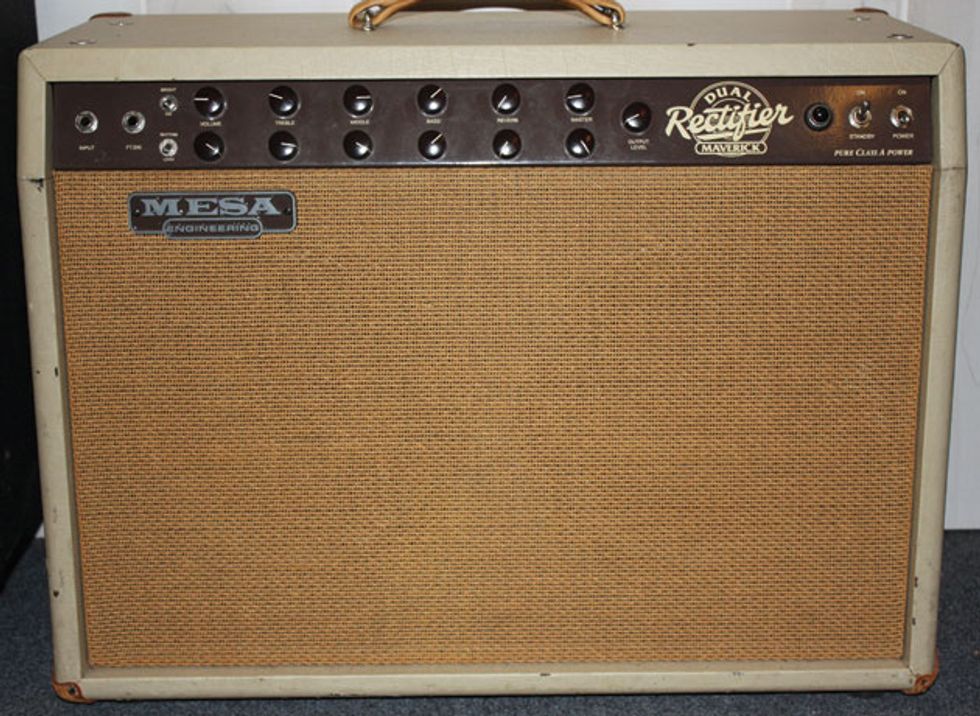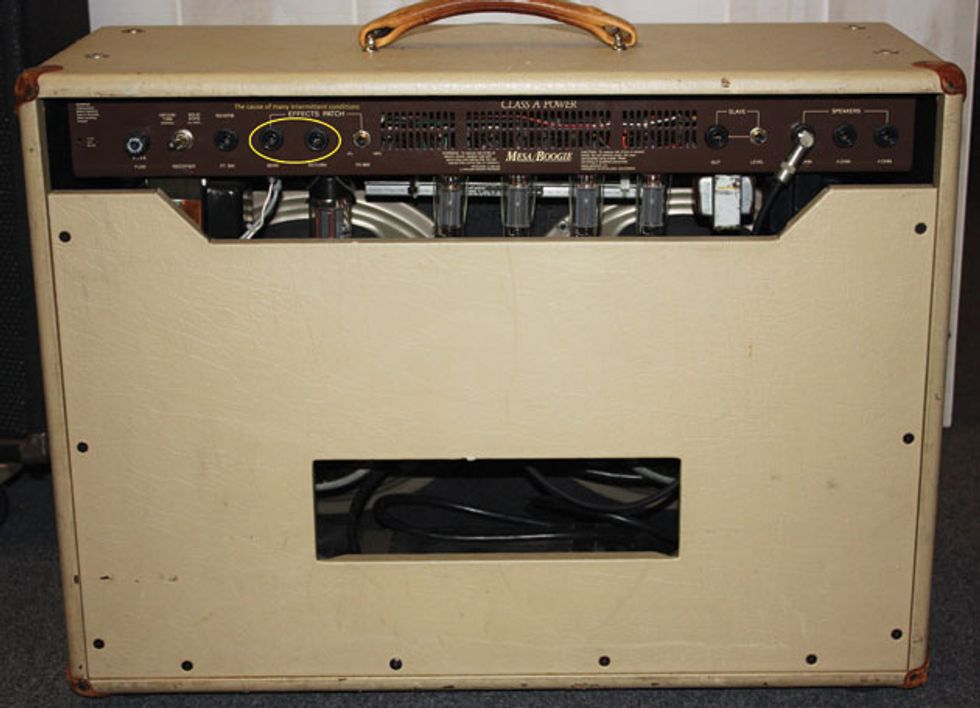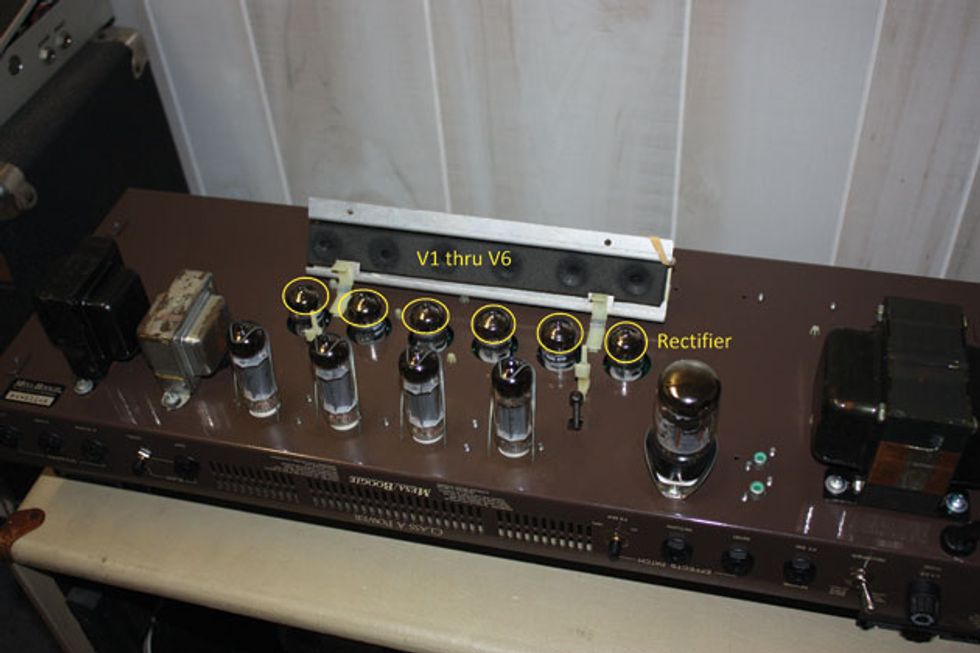When a Mesa/Boogie Maverick’s volume levels fluctuate or become intermittent, check the effects loop, sockets, and tubes.
Hi Jeff,
I just read your article about amp first aid ("Must Know Amp First-Aid") on Premier Guitar.com. It was a great article. Thanks for all the valuable info!
I have an issue that wasn’t exactly addressed and am hoping that you can point me in the right direction. I recently acquired a Maverick that sounded great when I got it. After a few months of light use (no gigging/moving the amp) it started having some issues. While I’m playing, the volume will drop intermittently. It doesn’t cut out completely, though. I told my cousin, who also plays guitar, and he said it needs a new set of tubes. If so, that’s fine, but a new set for this amp is a little over $200. I’m not one to throw parts at a problem and a whole set of tubes sounds like I’d be doing that. If it is a tube problem, is there any way to narrow down the issue to a particular tube(s)? Or could it be a completely different problem?
I appreciate any advice you can give me.
Best regards,
Brett
Hello Brett,
Thanks for reading PG and my column. Glad you were able to glean some valuable information from the amp first-aid article. It’s probably been helpful to many players at some point and should be required reading for a “How do I fix my own gear 101” class, but I’m sorry it didn’t go far enough to address your particular problem. I’ll try to give you a specific troubleshooting path to follow for your amp. Let’s go!
WARNING:
All tube amplifiers contain lethal voltages. The most dangerous voltages are stored in electrolytic capacitors, even after the amp has been unplugged from the wall. Before you touch anything inside the amp chassis, it’s imperative that these capacitors are discharged. If you are unsure of this procedure, consult your local amp tech.To start, I’m going to give you the easiest thing to check and I’m going to label it “Always Check Here First!” In any guitar amp with a passive effects loop, it is the first place I look for a symptom like this. In fact, if you rarely or never use the loop, it’s even more probable that it’s the cause of the problem. You see, in most passive effects loops (except those with “in/out” switches), the entire audio signal runs to the send jack, then through a set of switching contacts in the return jack, and finally to the rest of the circuitry—usually the output stage of the amp. When these contacts sit idle, they can become dirty or oxidized from lack of use and cause the signal to become intermittent (cut in and out).
The best way to find out if the problem is in the loop is to “jump” the loop using a short cable. An effects patch cable is best, but any cable will do. Simply plug one end into the send and the other into the return. And in the specific case of this amp, make sure the FX mix control is set to 100 percent. If this alleviates the symptom, you’ve found the problem.
Generally, a quick cleaning of the jacks with some electronic contact cleaner, preferably with lubricant, can remedy it. Simply spray some cleaner into the jack, work a plug in and out maybe 10 to 12 times, and then leave the plug inserted. Do this to both loop jacks and leave the plugs inserted until the cleaner evaporates. If you can leave them in overnight, that’s even better. Try the amp again to see if you’re back in business.
Now, if cleaning did not alleviate the problem, it’s okay to run the amp with the jumper in the loop until you can have the jacks replaced or, at least, the contacts professionally cleaned with a burnishing tool. If the loop wasn’t the cause, there’s more to check.
Any amp with a passive effects loop may develop volume issues if the send and return jacks become dirty or oxidized
and require cleaning.
We now move into the tube area, but we’re going to check the sockets as a possible cause first. The only tricky part is that you’ll need to wait until the amp actually acts up, which is the case with most intermittent problems. The reason it’s difficult for a tech to find an intermittent problem is that we actually need the failure to occur on the bench before we can find the source. If you don’t experience the symptom and pinpoint the source of the failure, you can never really be sure if you fixed the amp.
Anyway, when the problem begins to occur, one by one, starting with the preamp tube closest to the input jack, gently wiggle each tube to see if that has any effect on the symptom. (You may want to use a towel, napkin, or glove for this, and be very careful working around the much hotter output tubes). If it does, your problem may be a dirty or oxidized tube socket.
Be aware, as you’re doing this, that you may experience some crackling or popping noises. Fear not. While this may be an indication of a dirty tube socket or a bad tube, it’s in no way harmful to the amp. It may scare you at first, but trust me, those crackles and pops, even loud ones, are not as hard on an amp as when it’s turned up loud with a big ol’ dirtbox in front.
The only three tubes that affect the entire Mesa/Boogie Maverick amp are the V3 (effects loop return), V6 (phase inverter), and rectifier tube.
Back to the wiggles: If you find one of the sockets affecting the symptom, clean it well by spraying some electronic contact cleaner—this time without lubricant—in the socket and work the tube in and out eight to 10 times. Leave the tube out until the cleaner dries, reinsert, and try again. If this didn’t work, try replacing that tube, as I have seen bad pins on a tube that mimic bad tube sockets.
If neither cleaning nor tube replacement alleviates the problem, the socket may be bad or there may be an intermittent condition in that area of the board, which will require professional servicing. If none of the preamp tubes seem to be the problem, use the same procedure on the 5AR4 rectifier tube. This, however, will only be effective if the amp is in the vacuum rectifier setting. Just one point of technical information: The only three tubes that affect the entire amp are V3 (effects loop return), V6 (phase inverter), and the rectifier tube.
If no preamp tube, rectifier tube, or socket seems to be the cause of the failure, the next thing we look at are output tubes, but a failure here generally gives a different telltale sign. Generally, when an output tube fails, it shorts internally and often intermittently. When it does, it pulls the volume down, but this is typically accompanied by an increasing hum and red-plating tubes. If this is the case, I recommend replacing the full set of output tubes and having them biased, if necessary—although that’s unnecessary in the EL84 version.
Well, there you go. I hope that helps you maintain your Maverick without a full re-tube.










![Rig Rundown: Russian Circles’ Mike Sullivan [2025]](https://www.premierguitar.com/media-library/youtube.jpg?id=62303631&width=1245&height=700&quality=70&coordinates=0%2C0%2C0%2C0)


























